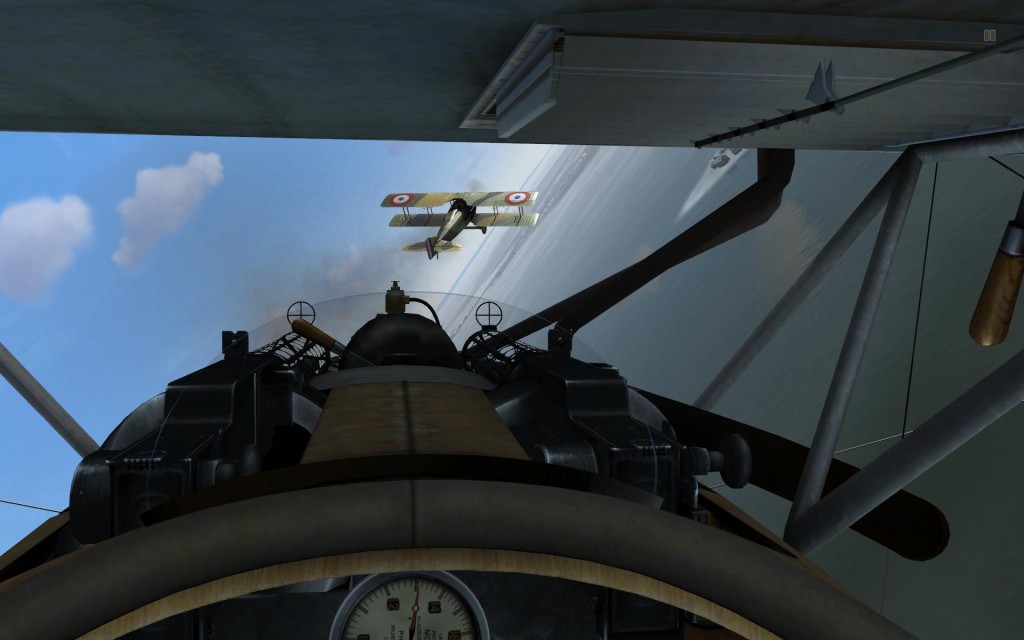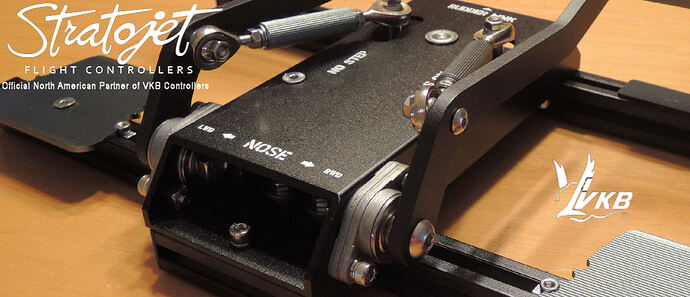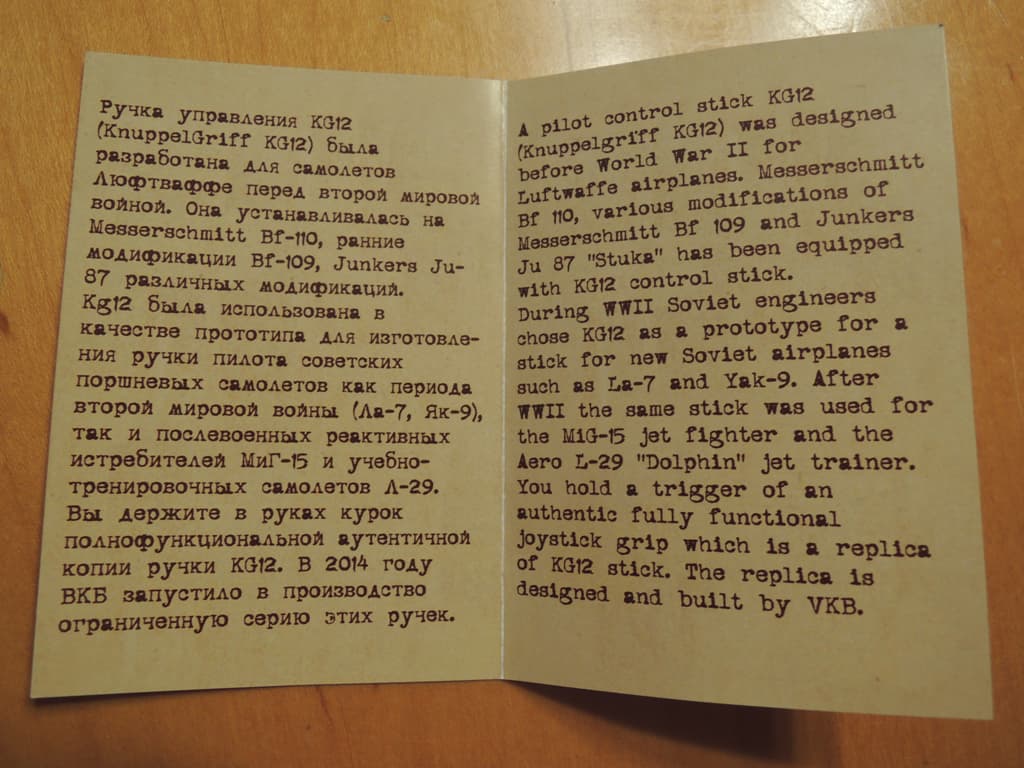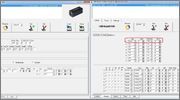VKB T-Rudder Mk III
By @EinsteinEP - September 23, 2015
Originally published at: Articles - Mudspike Forums
Although the HOTAS takes center stage when it comes to the home cockpit, rudder pedals are an understated and absolutely essential item for a fully immersive flight simulation experience. I won’t go so far as to say you can’t enjoy a good virtual flight with a twist-stick, but you sure will be missing out some of the feeling of control.
If you’ve never heard of VKB, you’re probably reading this from North America. VKB Flight Sim controllers are not very common on our continent, although the brand is well-known in Europe for their quality and customization. The Black Mamba Mk. II, for example, seems universally regarded as a high quality stick, and it sure looks the part!
![black-mamba-fat-02-853x1024[1]](https://uploads.mudspike.com/original/3X/c/d/cdf55e23cc08a25d10ddd0c85edbc5bf8ebc2869.jpeg) That’s one sexy stick!
That’s one sexy stick!
The T-Rudder Mk. III
The T-Rudder Mk. III clearly comes from a designer/manufacturer obsessed with quality. As I mentioned in a previous article, the quality of a product’s packaging is often a good indicator of the quality of the product itself, and the T-Rudder Mk. III comes in a pretty nice box.
First hands-on impression of the set is great. The all metal construction is sturdy and solid but the small size makes it very light, so it’s not clunky or cumbersome. The base legs are thin, which helps dig into carpet, preventing sliding, but they also have rubber footing running the entire length of those legs, ensuring a good grip on a hard flooring as well — a true multi-purpose design.
The textured metal heel pads and toe bars will no doubt survive more wear than I will ever give them and the body is matte black with military-style stencil writing on it, adding to that tactical feel. Nuts and bearings and other bits of metal gleam around the body, definitely making it look cool. I’ll be the first to admit that a bunch of metal does not a quality controller make, but it sure feels nice compared to the plastic-y feel of many other devices.
Also included the box is a little memento: a key chain made with the trigger from a replica Knupplegriff KG12, the control stick used in Luftwaffe and later Russian fighter aircraft. A completely unnecessary but nice touch — something I would have expected from an Elite or Collector’s edition — that definitely completes the feeling of having received something special.
Some Assembly Required
I was pleasantly surprised to find a wrench and hex keys in the packaging. A hex key I expected — VKB products are known for the customization — but the wrench was interesting. What am I going to need this for?
Turns out that the T-Rudder comes with some assembly required. The packaging includes a clear and concise quick-start guide which makes installation and customization a snap.
The heel bases can be adjusted along several different dimensions for a custom fit to your feet and playing style. The as-shipped configuration worked pretty good for me, so I haven’t touched it at the moment, but it’s good to know that was taken into account in the design.
The fasteners all look pretty standard to me: stuff I can go to Ace Hardware and pick up, if need be. It’s nice to know I don’t need to stockpile custom parts now, and I’ll never need to go to eBay to hunt for a custom shim or bracket.
The Dry Run
Once assembled, I give it a dry-run to see how it feels. The resistance pressure is light without being mushy and should be fine for most flying. The resistance force seems pretty constant – no increase as you move away from center. There’s a bit of a detent at center — there’s a slight click as you go through center and a bit of a bump — but as you’ll see later in my field test, this doesn’t have any effect on its performance. If the detent is an issue for you, there is an “undocumented feature” where you can open the bottom of the set and flip a part to greatly reduce the bump. This is only recommended for advanced users who just can’t live with the detent.
Pedal movement is vertical instead of horizontal, which means the unit is pretty compact. The T-Rudder will take up less space under your desk, will be less likely to snag cables, and should work well on the road, especially when coupled with a travel HOTAS. I was initially worried that I might find the vertical motion counter-intuitive in the heat of battle, but this was just not the case.
Installation to the computer is as simple as plugging it in. There’s a USB cable that goes to a “Tiny Box” adapter than then connects to the T-Rudder with a CAT-5E cable that is interestingly labeled “Not For Ethernet”. There’s no software to install, drivers to download, management software to tune, no nothing. I did calibrate the device using the Windows calibration tool and noticed there is an interface for two more axes and two buttons. Hmm…
During assembly, I noticed there aren’t any mechanisms for toe-brake inputs*. While I was initially concerned about this omission, this doesn’t turn out to be the game-stopper I thought it might be. There are plenty of aircraft in our virtual world that don’t use toe-brakes (DCS MiG-15bis, Rise of Flight aircraft, Battle of Stalingrad aircraft, etc.), so the T-Rudder would operate exactly like any other pedal set for these planes. There are definitely aircraft whose operation, at least on the ground, would be definitely affected by the lack of toe-brakes — DCS TF/P-51D, Concorde, etc. — but a field test is really required to test it out.
Field Test
Tailwheel and taildragger aircraft are the harshest critics of a pilot’s footwork on the ground, but I also want a challenge in the air, so I start up Rise of Flight where I can get both. The maneuverability of WWI kites demands a little more dancing on the pedals, so this should be a good all-around first test.
The vertical motion seems natural from the start, and I don’t even notice the detent during play. I’m able to accurately point the nose wherever I need to and have an overall good game.
 Fancy footwork is just as important as the control stick in WWI planes, and the T-Rudder does just fine here.
Fancy footwork is just as important as the control stick in WWI planes, and the T-Rudder does just fine here.
Next I tried a few aircraft in DCS World. With one notable exception, I found the rudder pedals worked great:
- Performance with DCS MiG-15bis was no surprise. The MiG-15bis doesn’t have toe brakes* anyways, so the T-Rudder worked just like any rudder pedals would. I did like the metal feel and solid positioning of the pedals under my feet.
- Flying through trees in my DCS UH-1H Huey was also pretty intuitive – the small and light T-Rudder rudder pedals may look a lot different from the native Huey dance shoes, but the result is the same. Not only could I stomp on the pedals and quickly get full deflection, but the light pedals and relatively short-range of motion made it easy to make the precise inputs needed to keep the Huey’s nose where I wanted it.
- Ground handling in the P-51D was a struggle, but this was also no surprise. The Mustang is a bear to handle on the ground, even for a pilot with tailwheel experience, and toe-brake control* is practically required to keep the beast in line. With a little practice I was able to execute a taxi circuit around Kobuleti, and even takeoff and land, so it can be done without toe brakes but the exercise was definitely a lot more challenging than with them.
- Although I didn’t get to try out Battle of Stalingrad, I expect the same experience as with Rise of Flight – the aircraft modeled in BoS didn’t use toe-brakes, and in the air…it’s all the same!
Purchase Point
Currently the T-Rudder Mk III is offered for sale in the US by Stratojet for an eye-opening $209.99 USD. This price does include sales tax and shipping to U.S. addresses. For our Canadian wingmen, there is an additional $25 USD delivery surcharge. While this price puts the T-Rudder up in the higher range of controllers, the workmanship and build quality of the device supports the price point. The lack of toe brakes* could be a concern for folks with ground handling for specific aircraft in mind but there are certainly lots of flight-sim experiences where the T-Rudder will shine. For example, Stratojet has bundle packages including the Mk III and Rise of Flight or Battle of Stalingrad, and the T-Rudder will deliver a great experience with either of these simulations.
Conclusion
VKB’s reputation as a quality controller designer and manufacturer is supported by the T-Rudder Mk III and I look forward to seeing more of their products entering our niche market. I’d certainly recommend the T-Rudder to the dedicated enthusiast, although I’d be sure they understood the device lacks toe brakes* before they toss their old pedals in the trash. The compact size, solid build, and quick response could easily make the T-Rudder Mk III the rudder pedal of choice for many home cockpits.
*Note: I’ve been informed that a Virtual Toe Brake feature is being developed for the T-Rudder will provide some sort of differential braking. I’m very much looking forward to learning more about this feature!





















